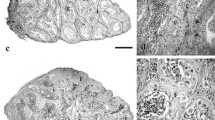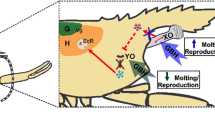Abstract
To examine the role of the retinoid X receptor (RXR) in the development of imposex in gastropods, we investigated the time course of expression of the RXR gene in various tissues (ctenidium, ovary or testis, digestive gland, penis-forming area or penis, and head ganglia) of female and male rock shells (Thais clavigera) exposed to triphenyltin (TPT) in a flow-through exposure system for 3 months. Accumulations of TPT in tissues were clearly observed in exposed individuals, whereas no accumulation of TPT was observed in the control groups. In females, 3-month exposure to TPT resulted in the development of imposex, and penis lengths in imposex-exhibiting females were significantly longer in small females (shell height <20 mm) than in large females (shell height ≥20 mm). RXR gene expression in the ovary, penis-forming area or penis, and head ganglia of females exposed for 3 months was significantly higher than expression in control females, and the highest RXR gene expression was found in the penis-forming area or penis. Moreover, RXR gene expression in the penis-forming area or penis of each female exposed to TPT seemed to be associated with an increase in penis length. In males, the ratio of penis length to shell height was significantly larger in the exposed groups than in the controls. Although RXR gene expression in males exposed for 3 months was not significantly higher than expression in control males in any tissues, the highest gene expression was observed in the penis of exposed males. These results suggest that RXR plays an important role in the development of male genitalia (i.e., penis and vas deferens) in gastropods, although RXR might also have other physiological functions.

Relationships between average penis length and RXR gene expression in penis-forming area/penis and ovary of female rock shells exposed to 500 ng/L of triphenyltin chloride (TPTCl) for 3 months in a flow-through system. TPT, triphenyltin. Bars in the upper and middle figures represent normalized RXR gene expression in ovary and penis-forming area/penis of females exposed to TPTCl, respectively. Dots or symbols in the bottom figure represent measured values of penis length of each female in the respective composite samples. RXR gene expression in the penis-forming area or penis of each female exposed to TPT seems to be associated with an increase in penis length, however, that in ovary does not.








Similar content being viewed by others
References
Bryan GW, Gibbs PE, Hummerstone LG, Burt GR (1986) J Mar Biol Assoc UK 66:611–640
Smith BS (1971) Proc Malacol Soc Lond 39:377–378
Bryan GW, Gibbs PE, Burt GR, Hummerstone LG (1987) J Mar Biol Assoc UK 67:525–544
Bryan GW, Gibbs PE, Burt GR (1988) J Mar Biol Assoc UK 68:733–744
Gibbs PE, Bryan GW, Pascoe PL, Burt GR (1987) J Mar Biol Assoc UK 67:507–523
Horiguchi T, Shiraishi H, Shimizu M, Morita M (1994) J Mar Biol Assoc UK 74:651–669
Horiguchi T, Shiraishi H, Shimizu M, Morita M (1997) Environ Pollut 95:85–91
Gibbs PE, Bryan GW (1986) J Mar Biol Assoc UK 66:767–777
Gibbs PE, Pascoe PL, Burt GR (1988) J Mar Biol Assoc UK 68:715–731
Gibbs PE, Bryan GW, Pascoe PL, Burt GR (1990) J Mar Biol Assoc UK 70:639–656
Horiguchi T, Kojima M, Hamada F, Kajikawa A, Shiraishi H, Morita M, Shimizu M (2006) Environ Health Perspect 114(Suppl 1):13–19
Fioroni P, Oehlmann J, Stroben E (1991) Zool Anz 226:1–26
Horiguchi T, Shiraishi H, Shimizu M, Morita M (1997) Appl Organomet Chem 11:451–455
Horiguchi T (2000) In: Kawai S, Koyama J (eds) Problems of endocrine disruptors in fisheries environment. [in Japanese] Koseisha-Koseikaku, Tokyo
Matthiessen P, Reynoldson T, Billinghurst Z, Brassard DW, Cameron P, Chandler GT, Davies IM, Horiguchi T, Mount DR, Oehlmann J, Pottinger TG, Sibley PK, Thompson A, Vethaak AD (1999) In: de Fur PL, Ingersoll C, Tattersfield L (eds) Endocrine disruption in invertebrates: endocrinology, testing, and assessment. SETAC, Florida
Matthiessen P, Gibbs PE (1998) Environ Toxicol Chem 17:37–43
Bettin C, Oehlmann J, Stroben E (1996) Helgol Meeresunters 50:299–317
Ronis MJJ, Mason AZ (1996) Mar Environ Res 42:161–166
Féral C, Le Gall S (1983) In: Lever J, Boer HH (eds) Molluscan neuro-endocrinology. North-Holland, Amsterdam
Oberdörster E, McClellan-Green P (2000) Peptides 21:1323–1330
Horiguchi T (2009) In: Arai T, Harino H, Ohji M, Langston WJ (eds) Ecotoxicology of antifouling biocides. Springer, Tokyo
Nishikawa J, Mamiya S, Kanayama T, Nishikawa T, Shiraishi F, Horiguchi T (2004) Environ Sci Technol 38:6271–6276
Bouton D, Escriva H, de Mendonca RL, Glineur C, Bertin B, Noël C, Robinson-Rechavi M, de Groot A, Cornette J, Laudet V, Pierce RJ (2005) J Mol Endocrinol 34:567–582
Devine C, Hinman VF, Degnan BM (2002) Int J Biol 46:687–692
Freebern WJ, Osman A, Niles EG, Christen L, LoVerde PT (1999) J Biol Chem 247:4577–4585
Heyman RA, Mangelsdorf DJ, Dyck JA, Stein RB, Eichele G, Evans RM, Thaller C (1992) Cell 68:397–406
Kamimura M, Fujiwara S, Kawamura K, Yubisui T (2000) Dev Growth Differ 42:1–8
Kostrouch Z, Kostrouchova M, Love W, Jannini E, Piatigorsky J, Rall JE (1998) Proc Natl Acad Sci USA 95:13442–13447
Mangelsdorf DJ, Evans RM (1995) Cell 83:841–850
Mangelsdorf DJ, Borgmeyer U, Heyman RA, Zhou JY, Ong ES, Oro AE, Kakizuka A, Evans RM (1992) Genes Dev 6:329–344
Nagatomo K, Ishibashi T, Satou Y, Satoh N, Fujiwara S (2003) Mech Dev 120:363–372
Wiens M, Batel R, Korzhev M, Muller WE (2003) J Exp Biol 206:3261–3271
Horiguchi T, Nishikawa T, Ohta Y, Shiraishi H, Morita M (2007) Aquat Toxicol 84:379–388
Horiguchi T, Urushitani H, Ohta Y, Iguchi T, Shiraishi H (2009) Ecotoxicol under review
Horiguchi T (1993) Imposex Caused by Organotin Compounds in Marine Gastropods from Japan [PhD Thesis, in Japanese]. Bunkyo-ku, Tokyo: The University of Tokyo
Yamada H, Takayanagi K (1992) Water Res 26:1589–1595
Higuchi R, Fockler C, Dollinger G, Watson R (1993) Biotechnol 11:1026–1030
Heid CA, Stevens J, Livak KJ, Williams PM (1996) Genome Res 6:986–994
Bryan GW, Bright DA, Hummerstone LG, Burt GR (1993) J Mar Biol Assoc UK 73:889–912
Horiguchi T, Takiguchi N, Cho HS, Kojima M, Kaya M, Shiraishi H, Morita M, Hirose H, Shimizu M (2000) Mar Environ Res 50:223–229
Horiguchi T, Shiraishi H, Morita M (2003) [Abstract] SETAC 24th Annual Meeting Abstract Book, p 290
Horiguchi T, Kojima M, Takiguchi N, Kaya M, Shiraishi H, Morita M (2005) Mar Pollut Bull 51:817–822
Mensink B, Boon JP, ten Hallers-Tjabbes CC, van Hattum B, Koeman JH (1997) Environ Technol 18:1235–1245
Bock R (1981) In: Gunter FA, Gunter JD (eds) Residue reviews, vol 79. Springer, New York
Lee RF (1985) Mar Environ Res 17:145–148
Matsuda R, Suzuki T, Saito Y (1993) J Agric Food Chem 41:489–495
Suzuki T, Kondo K, Uchiyama M, Murayama M (1999) J Agric Food Chem 47:4791–4798
Horiguchi T, Shiraishi H, Shimizu M, Yamazaki S, Morita M (1995) Mar Pollut Bull 31:402–405
Horiguchi T, Ohta Y, Nishikawa T, Shiraishi F, Shiraishi H, Morita M (2008) Cell Biol Toxicol 24:553–562
Fent K (1996) Crit Rev Toxicol 26:1–117
Horiguchi T, Nishikawa T, Ohta Y, Shiraishi H (2008) [Abstract] SETAC Europe 18th Annual Meeting Abstract Book, p 150
Levin AA, Sturzenbecker LJ, Kazmer S, Bosakowski T, Huselton C, Allenby G, Speck J, Kratzeisen C, Rosenberger M, Lovey A (1992) Nature 355:359–361
Horton C, Maden M (1995) Dev Dyn 202:312–323
Dmetrichuk JM, Carlone RL, Jones TRB, Vesprini ND, Spencer GE (2008) J Neurosci 28:13014–13024
Escriva H, Safi R, Hanni C, Langlois MC, Saumitou-Laprade P, Stehelin D, Capron A, Pierce R, Laudet V (1997) Proc Natl Acad Sci USA 94:6803–6808
Nagatomo K, Fujiwara S (2003) Gene Expr Patterns 3:273–277
de Urquiza AM, Liu S, Sjoberg M, Zetterstrom RH, Griffiths W, Sjovall J, Perlmann T (2000) Science 290:2140–2144
Castro LFC, Lima D, Machado A, Melo C, Hiromori Y, Nishikawa J, Nakanishi T, Reis-Henriques MA, Santos MM (2007) Aquat Toxicol 85:57–66
Acknowledgment
This work was supported partly by Grants-in-Aid for Scientific Research from the Japan Society for the Promotion of Science (Scientific Research [B], no. 17380121).
Author information
Authors and Affiliations
Corresponding author
Rights and permissions
About this article
Cite this article
Horiguchi, T., Nishikawa, T., Ohta, Y. et al. Time course of expression of the retinoid X receptor gene and induction of imposex in the rock shell, Thais clavigera, exposed to triphenyltin chloride. Anal Bioanal Chem 396, 597–607 (2010). https://doi.org/10.1007/s00216-009-3230-x
Received:
Revised:
Accepted:
Published:
Issue Date:
DOI: https://doi.org/10.1007/s00216-009-3230-x




